In this post, we will set up Alexa to talk to your Nanoleaf Aurora. We will cover a quick basic setup, as well additional Alexa features to get the most out of your setup. If you have not already set up and configured your Aurora with the Nanoleaf app, check out our extensive, updated post here: Nanoleaf Aurora How To: Setup and Configuration to the Muks!
Estimated reading time: 15 minutes
Table of contents
Prepare your Nanoleaf Aurora for Alexa
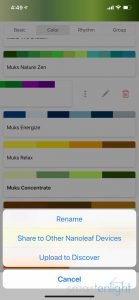
Clean up / Rename your Aurora Scenes
Every scene in your Nanoleaf app dashboard will be synchronized to Alexa. Chances are, that you have some old, experimental scenes in your list with potentially inconsistent names, so it’s a good time to clean up:
- In the Nanoleaf app dashboard, swipe left on the scene you don’t need any more and tap the delete button.
- Alternatively, swipe left on the scene, tap the three dots, and rename it. To avoid ambiguous scene names, we’d recommend to prefix the scenes with the device name, e.g. “Muks Relax”, especially if you also have other smart lights and scenes.
Create a Nanoleaf Cloud Account
To support Alexa and Google (as well as IFTTT), Nanoleaf has created the Nanoleaf Cloud. You’ll need to create an account there, if you have not already:
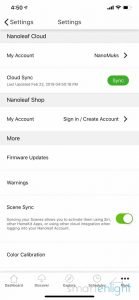
- Under “… More”, bottom right in your Nanoleaf app,
- tap “Settings” and on top of the screen, you will find the “Nanoleaf Cloud” settings.
- Tap “username” and register yourself.
- (Click the “Sync” button to synchronize your configuration with the Nanoleaf cloud.) Note, this should happen automatically, check the “last time” date and time.
Link the Nanoleaf Skill in the Alexa App
Enable the Nanoleaf Skill
- In your Alexa app go to the menu (burger menu, top left)
- Tap on “Skills & Games”
- Search for “Nanoleaf” (magnifying glass, top right)
- Enable the skill
- You will be guided to enter the Nanoleaf Cloud account we’ve created above to link Alexa to your Nanoleaf Aurora
- Click “Allow” to let Alexa control your Nanoleaf devices
- The app will display that the skill has been successfully linked
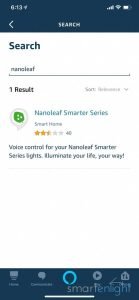
Let Alexa Discover your Smart Home Devices
- Alexa will now discover your devices, this may take up to one minute, and should come back with 1 new device (your Aurora) and n Scenes (all your Aurora Scenes).
- Note, if Alexa doesn’t start the discovery by herself, tell her: “Alexa, discover devices!”
- Alexa will then guide you to add your Nanoleaf Aurora to an Alexa Group. It’s best to skip this step for now, we’ll look into Alexa Groups later.
Basic Voice Commands
Without further ado, we are able to talk to our Nanoleaf Aurora now:
- Alexa turn on/off <Aurora name>
- Alexa, dim/brighten <Aurora name> (by x percent)
- Alexa, set <Aurora name> to x (percent)
- Alexa, set the <Aurora name> to <color> Note, check the list below for shades of white and colors
- Alexa turn on <Aurora scene>.
- Alexa, make the <Aurora name> warmer/cooler. Note, this requires a shade of white.
Alexa’s Shades of White
- Warm white,
- soft white,
- white,
- daylight white,
- cool white.
Alexa’s Colors
- Red,
- Crimson,
- Salmon,
- Orange
- Gold;
- Yellow,
- Green
- Turquoise
- Cyan
- Sky blue
- Blue
- Purple
- Magenta
- Pink
- Lavender
Pro-Tip: There are many voice command alternatives you can use with Alexa and smart lighting. Pick the ones which work best for you from the overview in this post: Alexa and Philips Hue: Setup, Review and Voice Commands.
Should I create Alexa Groups and/or Alexa Routines and what for?
Let’s look at the different use-cases you might have:
- If Aurora is your one and only smart home device, you can skip Alexa Groups.
- If you control some regular lights with smart plugs and/or have other smart lights, maybe from other manufacturers (e.g. Philips Hue), which you already control with Alexa, definitely have a look at Alexa Groups to synchronize Aurora with your current setup.
- If you have multiple Amazon Echos and smart lights spread throughout the rooms in your home, definitely have a look at Alexa Groups. You’ll be able to use the short voice commands “lights on/off” in those rooms, etc. as well as “Turn on <group name>” commands from everywhere.
- Also have a look at Alexa Groups, if you would like to have overlapping groups, for instance control multiple lights of different areas of your living room (as groups), but also your living room altogether (as group), including scenes.
- Have a look at Alexa Groups, if you’d like to control your rooms from a screen device, like your Alexa app or an Echo Show.
- If you would like to set your Aurora scenes together with playing your favorite music playlists/stations from Alexa, have a look at Alexa Routines.
- If you want to schedule your light scenes with Alexa, have a look at Alexa Routines.
What are Alexa Groups?
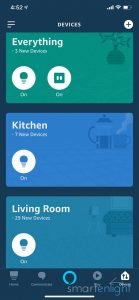
- You can create Alexa Groups to represent your rooms (but also scenes, which we will explore later).
- An Alexa Group can contain multiple smart home devices. A smart home device can be added to multiple Alexa Groups. Note, an Amazon Echo device can only be added to one Alexa Group.
- One command: “Alexa, turn on <group name>” will activate all the devices in the group
- If your Amazon Echo is physically located in a room with smart lights, you can create a corresponding Alexa Group and add your Echo to it. Alexa will switch only the lights in this room/group, when you say: “Alexa, lights on/off” or “Alexa, dim the lights”. This works with every Alexa Group, if you have an Echo and smart lights added.
Pro-Tip: do not add scenes to the groups where your devices are in! Not only, that this does not help with any voice commands (you cannot have a “Relax” scene for your bedroom and a “Relax” scene for your living room, Alexa cannot handle this) but all added scenes would also be set (quickly after each other) when you turn on the group by using it’s name, e.g. “Alexa, turn on living room”.
What are Alexa Routines?
Here’s Alexa explaining her routines, from our post: Alexa Routines: How to Automate your Life with your Amazon Echo.
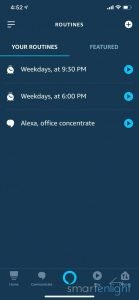
- Alexa Routines can be activated by: your custom voice command, schedule, your location or an Echo Button (or a restricted set of devices/sensors).
- One command: “Alexa, <routine name>” will perform all the actions defined in an Alexa Routine.
- An Alexa Routine can perform multiple actions at once.
- Actions can include controlling your smart home devices, smart home groups and/or smart home scenes. Actions could also play your music, and give you calendar, news, weather or traffic information and more.
Basic Setup of Alexa Groups and Routines
Adding Nanoleaf Aurora to one Alexa Group
Let’s start with a basic example of adding Aurora to one Alexa Group:
- Go to the devices (bottom right) view in your Alexa app.
- If you’ve already created a group, select it and click “Edit” at the top right, otherwise click on the “+” at the top right and
- select “Add Group” Name the group (we’re taking “Office” as example)
- tap the “Next” button
- Select all the devices which should be part of this group, this includes
- Your Amazon Echo Device (it must not be part of any other group)
- Your Nanoleaf Aurora
- Your other smart lights (some Philips Hue’s in this case)
- Any smart plugs which control your lighting or other devices
- Any other smart home devices
- Do not select any Aurora scenes here!
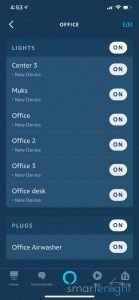
Group Voice Commands
You can now enter your office, and say
- Alexa, lights on/off
- Alexa, dim/brighten the lights
- Alexa, set the lights (to) <color>
and all your devices including your Nanoleaf Aurora in this group will play along. Additionally, you can command from any Amazon Echo device in your setup:
- Alexa, (turn the) <office> on/off
- Alexa, dim/brighten the <office> lights (to x percent)
- Alexa, set the <office> lights (to) <color>
If you’re interested in synchronizing multiple scenes check out the Pro Setup example below.
Add some Music with Alexa Routines
We’re in the office and we would like to … concentrate. You could think of less boring examples, like a romantic candle light dinner, or your morning news briefing and traffic update while sipping your coffee, realizing you’re going to be too late for a meeting, but I’m already sitting here in the office now. Let’s set the scene:
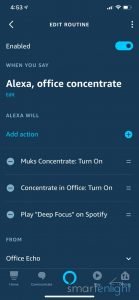
- Select routines from the Alexa app menu (top left)
- Tap on the “+” top right
- Tap on “when this happens”
- Select “Voice” and add your custom command (here “Office Concentrate”), tap “SAVE”
- Select “Add Action”, tap “Smart Home”, “control scene” and select
- your favorite Aurora scene for concentration, here “Muks Concentrate”, tap “Add”
- Add other smart lighting scenes, like Concentrate in Office (this is what Philips Hue synchronized to our Alexa), tap “Add”
- Alternatively adapt the settings of your smart home devices by tapping “Add Action”, tap “Smart Home”, “control device” to the state which fits your concentration
- Select “Add Action”, tap “Music” and
- enter your favorite playlist, album or station, “deep focus” in this case
- select the provider, “Spotify” in this example, tap “Next”
We are ready! Just need to say:
- Alexa, office concentrate
and all our lights including our Aurora will switch to our preferred setting. Additionally our Echo will play our preferred music. By the way, don’t forget to check out Alexa’s top post – Alexa, Play Some Music: All The Music Voice Commands!
Here are some Pro examples.
Pro Setup of Alexa Groups and Routines
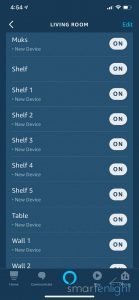
Alexa Groups within Alexa Groups, also Controlling Scenes
In this example our Aurora is currently above the dining table in the living room. There are (too) many lights in the living room, so we’ve segmented them into different areas: “Couch”, where we usually watch TV. “Table”, where we usually eat, “Shelf”, which is a monstrous bookshelf where we like to read, and “Kitchen”, which is an open kitchen and hence part of the living room.
The idea is, that we can control and set different scenes for every area, like “read at the table” and “relax at the couch” as well as “concentrate in the kitchen” and so on. However, since we see all the lights all of the time, we would like to have overall control for the areas and want to be able to set all of them to a specific scene e.g. living room relax. Our Muks should react in this example to “table” commands as well as “living room” commands.
Here’s what we’ll need:
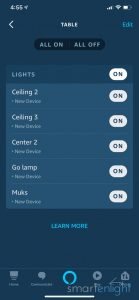
- Create an Alexa Group for your living room areas, here: Kitchen, Table (with Muks), Couch and Shelf and add all the Amazon Echo devices and smart lights to the appropriate groups.
- Create an Alexa Group for the living room: add the Kitchen, Table (Muks in here), Couch and Shelf smart lights to this group (and the central Amazon Echo device which controls your living room, the one which should react to “lights on”, when you’re in the living room).
- For every scene in the living room area where your Aurora is located (here Table): create a “scene” group and select the appropriate scenes. Here we have “table read” combining “Muks read” and “Read in Table” from Philips Hue.
- For every scene in your “living room”: create a group and select the appropriate scenes. Here we have “living room relax” combining the Muks relax scene with all the relax scenes from all the living room areas.
Congrats! Your Nanoleaf Aurora is now part of two overlapping groups, and you can switch your Aurora Scenes together with scenes of both groups.

- Alexa, (turn the) lights on/off will control all your living room lights (or your kitchen lights if you command an Echo device in your kitchen area).
- Alexa, (turn the) <table/kitchen/shelf/couch/…> lights on/off will control the lights in the respective living room area
- Alexa, dim/brighten the lights will control all your living room lights.
- Alexa, dim/brighten (the) <table/kitchen/shelf/couch/…> lights will control the lights in the respective living room area
- Alexa, turn on living room <scene> will set the scene for the living room
- Alexa, turn on <scene> in <kitchen/shelf/couch/…> will control the lights in the respective living room areas. Note, these came from Philips Hue, but you can of course create your own.
- Alexa, turn table <scene> will set the scene in the living room area, where your Aurora is located.
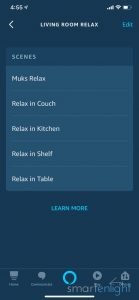
Pro Group Setup Bonus
Now, that we’ve made it through this complex example, here are some simpler group ideas:
- Create a group “everything” and add all the devices you like to turn off when you say “Alexa, turn everything off”
- If you have a downstairs and upstairs, create groups to be able to control your lights in these areas. “Alexa, turn off upstairs”
Scheduling your lights with Alexa Routines
We’ve already created an Alexa Routine to set an Aurora scene and play some music with a voice command, but we can also schedule our Alexa Routines. Let’s have the “Relax” scene scheduled at 6:00 pm and the “Nightlight” scene activated at 9 pm every weekday.
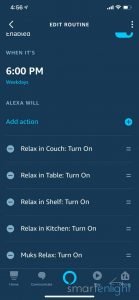
Note, to gradually dim/brighten your Nanoleaf Aurora over a period from one second to up to one hour, check out the “Schedules” feature in your Nanoleaf app. Nanoleaf does not provide Sunrise/Sunset schedules yet, but we can do this now in the Alexa app.
Pro Tip: To achieve natural light transitions over time, try to find the (native) app with the most features to automate your different smart lights. We have schedules distributed over 4 apps to get the most out of our different smart home lights.
Updating your Nanoleaf Aurora Scenes
So you’ve changed or added an Aurora scene and want Alexa to update? Make sure you have synchronized your changes to the Nanoleaf Cloud!
- Alexa, discover scenes/devices
should do the trick. If you have removed an Aurora scene, you’ll need to
- memorize which scenes you’ve deleted
- manually delete them from the Alexa app: under Devices / Scenes, tap on the scene and then delete (on the top right).
Pro-Tip: Alexa’s web interface at alexa.amazon.com, provides insight into which Aurora scenes are “offline”. This will help to figure out, what you have deleted. It also provides a “forget all” button for all scenes, but be aware that this deletes all groups you have created!
Conclusion
Nanoleaf and Alexa provide an excellent integration. Additionally to scenes, brightness and color control, also color temperature can be set.
What we’re missing is broader sensor support from Alexa to automate our smart lights based on e.g. motion sensors. Alexa currently only supports Echo Buttons as smart switches to control our smart devices.
With Alexa Groups and Routines, Alexa provides us great features, to further streamline automation and voice control of our Nanoleaf Aurora, also in combination with our other smart home devices.
We hope you’ve enjoyed this post and it helps you to get the most out of your Nanoleaf with Alexa setup! If you have any questions or would like to share your experience with Nanoleaf and Alexa, please leave a comment in the section below.
Happy Nanoleaf with Alexa!
P.S. You can find more Alexa posts here: Amazon Alexa
For the Nanoleaf Rhythm Module, please see Nanoleaf Aurora and the Rhythm Module: Visualize Your Music. And, for the Nanoleaf Remote: Nanoleaf Remote Setup – The Shape of the Universe?
For a comparison to Siri and Google Assistant, please see: Assistant Showdown with Nanoleaf Aurora: Who will win, Siri, Alexa or Google Assistant?


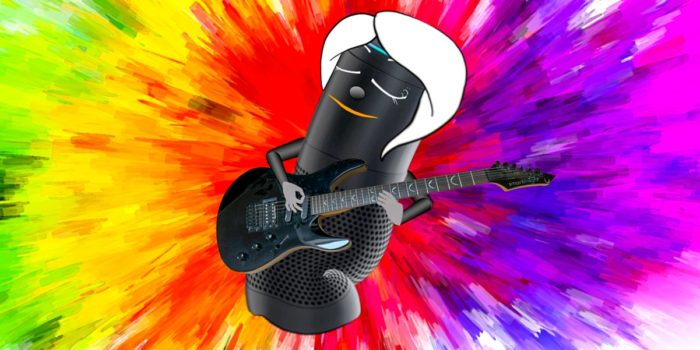
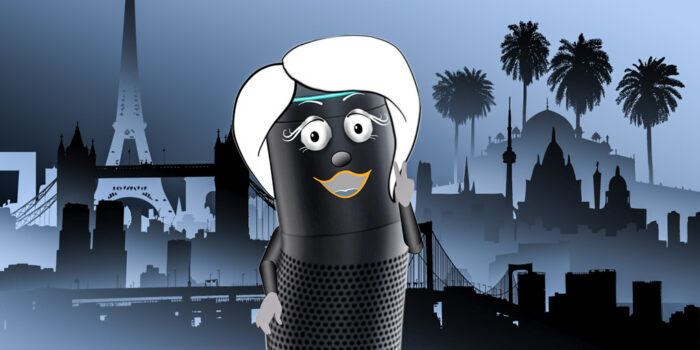
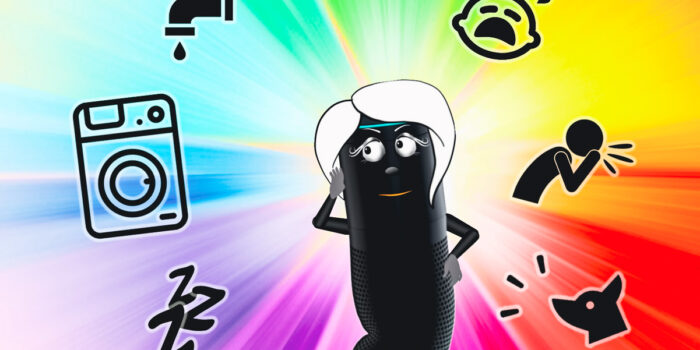
Added sunrise/sunset automations, which are now available in the Alexa app.